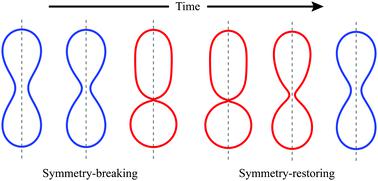当前位置:
X-MOL 学术
›
Soft Matter
›
论文详情
Our official English website, www.x-mol.net, welcomes your
feedback! (Note: you will need to create a separate account there.)
Active shape oscillations of giant vesicles with cyclic closure and opening of membrane necks.
Soft Matter ( IF 2.9 ) Pub Date : 2020-09-07 , DOI: 10.1039/d0sm00790k Simon Christ 1 , Thomas Litschel 2 , Petra Schwille 2 , Reinhard Lipowsky 1
Soft Matter ( IF 2.9 ) Pub Date : 2020-09-07 , DOI: 10.1039/d0sm00790k Simon Christ 1 , Thomas Litschel 2 , Petra Schwille 2 , Reinhard Lipowsky 1
Affiliation

|
Reaction-diffusion systems encapsulated within giant unilamellar vesicles (GUVs) can lead to shape oscillations of these vesicles as recently observed for the bacterial Min protein system. This system contains two Min proteins, MinD and MinE, which periodically attach to and detach from the GUV membranes, with the detachment being driven by ATP hydrolysis. Here, we address these shape oscillations within the theoretical framework of curvature elasticity and show that they can be understood in terms of a spontaneous curvature that changes periodically with time. We focus on the simplest case provided by a attachment–detachment kinetics that is laterally uniform along the membrane. During each oscillation cycle, the vesicle shape is transformed from a symmetric dumbbell with two subcompartments of equal size to an asymmetric dumbbell with two subcompartments of different size, followed by the reverse, symmetry-restoring transformation. This sequence of shapes is first analyzed within the spontaneous curvature model which is then extended to the area-difference-elasticity model by decomposing the spontaneous curvature into a local and nonlocal component. For both symmetric and asymmetric dumbbells, the two subcompartments are connected by a narrow membrane neck with a circular waistline. The radius of this waistline undergoes periodic oscillations, the time dependence of which can be reasonably well fitted by a single Fourier mode with an average time period of 56 s.
中文翻译:

巨大囊泡的主动形状振荡,具有周期性的闭合和膜颈部开口。
封装在巨型单层囊泡(GUV)中的反应扩散系统会导致这些囊泡的形状振荡,正如最近针对细菌Min蛋白系统观察到的那样。该系统包含两种Min蛋白,MinD和MinE,它们定期附着在GUV膜上或从GUV膜上分离,而分离是由ATP水解驱动的。在这里,我们在曲率弹性的理论框架内解决了这些形状振荡问题,并表明可以根据随时间周期性变化的自发曲率来理解它们。我们关注的是沿膜横向均匀的附着-分离动力学所提供的最简单的情况。在每个振荡周期中 囊泡形状从具有两个相等大小的子小室的对称哑铃转变为具有两个不同大小的小子室的非对称哑铃,然后进行反向对称恢复变换。首先在自发曲率模型中分析此形状序列,然后通过将自发曲率分解为局部和非局部分量,将其扩展到面积差弹性模型。对于对称和非对称哑铃,两个子隔间通过带有圆形腰线的窄膜颈连接。该腰围的半径经历周期性振荡,其时间依赖性可以通过平均时间为56 s的单个傅里叶模式很好地拟合。首先在自发曲率模型中分析此形状序列,然后通过将自发曲率分解为局部和非局部分量,将其扩展到面积差弹性模型。对于对称和非对称哑铃,两个子隔间通过带有圆形腰线的窄膜颈连接。该腰围的半径经历周期性振荡,其时间依赖性可以通过平均时间为56 s的单个傅里叶模式很好地拟合。首先在自发曲率模型中分析此形状序列,然后通过将自发曲率分解为局部和非局部分量,将其扩展到面积差弹性模型。对于对称和非对称哑铃,两个子隔间通过带有圆形腰线的窄膜颈连接。该腰围的半径经历周期性振荡,其时间依赖性可以通过平均时间为56 s的单个傅里叶模式很好地拟合。两个小隔间通过一个带有圆形腰线的窄膜颈连接。该腰围的半径经历周期性振荡,其时间依赖性可以通过平均时间为56 s的单个傅里叶模式很好地拟合。两个小隔间通过一个带有圆形腰线的窄膜颈连接。该腰围的半径经历周期性振荡,其时间依赖性可以通过平均时间为56 s的单个傅里叶模式很好地拟合。
更新日期:2020-09-11
中文翻译:

巨大囊泡的主动形状振荡,具有周期性的闭合和膜颈部开口。
封装在巨型单层囊泡(GUV)中的反应扩散系统会导致这些囊泡的形状振荡,正如最近针对细菌Min蛋白系统观察到的那样。该系统包含两种Min蛋白,MinD和MinE,它们定期附着在GUV膜上或从GUV膜上分离,而分离是由ATP水解驱动的。在这里,我们在曲率弹性的理论框架内解决了这些形状振荡问题,并表明可以根据随时间周期性变化的自发曲率来理解它们。我们关注的是沿膜横向均匀的附着-分离动力学所提供的最简单的情况。在每个振荡周期中 囊泡形状从具有两个相等大小的子小室的对称哑铃转变为具有两个不同大小的小子室的非对称哑铃,然后进行反向对称恢复变换。首先在自发曲率模型中分析此形状序列,然后通过将自发曲率分解为局部和非局部分量,将其扩展到面积差弹性模型。对于对称和非对称哑铃,两个子隔间通过带有圆形腰线的窄膜颈连接。该腰围的半径经历周期性振荡,其时间依赖性可以通过平均时间为56 s的单个傅里叶模式很好地拟合。首先在自发曲率模型中分析此形状序列,然后通过将自发曲率分解为局部和非局部分量,将其扩展到面积差弹性模型。对于对称和非对称哑铃,两个子隔间通过带有圆形腰线的窄膜颈连接。该腰围的半径经历周期性振荡,其时间依赖性可以通过平均时间为56 s的单个傅里叶模式很好地拟合。首先在自发曲率模型中分析此形状序列,然后通过将自发曲率分解为局部和非局部分量,将其扩展到面积差弹性模型。对于对称和非对称哑铃,两个子隔间通过带有圆形腰线的窄膜颈连接。该腰围的半径经历周期性振荡,其时间依赖性可以通过平均时间为56 s的单个傅里叶模式很好地拟合。两个小隔间通过一个带有圆形腰线的窄膜颈连接。该腰围的半径经历周期性振荡,其时间依赖性可以通过平均时间为56 s的单个傅里叶模式很好地拟合。两个小隔间通过一个带有圆形腰线的窄膜颈连接。该腰围的半径经历周期性振荡,其时间依赖性可以通过平均时间为56 s的单个傅里叶模式很好地拟合。











































 京公网安备 11010802027423号
京公网安备 11010802027423号